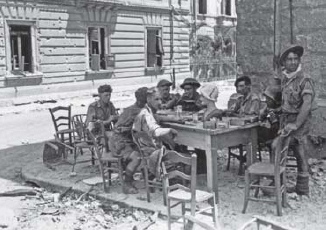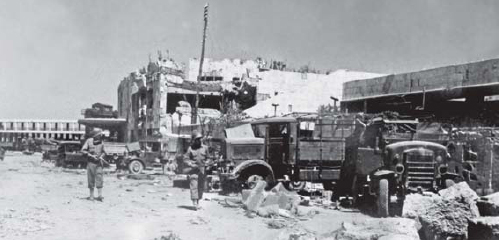
Axis losses during Operation Husky were severe, especially for the Italians. Total Italian losses were about 4,680 killed, 5,000 wounded, and about 152,000 missing or captured for a total of about 162,000. German losses were 4,561 killed, 4,583 missing, and 5,523 captured for a total of 14,667; a further 13,532 were wounded and evacuated for a grand total of about 28,000. The Germans lost 170 of 217 tanks and assault guns, while Italian AFV losses were total. Although Kesselring later boasted that the evacuated divisions were ready for service, this was a considerable exaggeration. The three principal German divisions involved in combat had lost well over half their effective combat strength in personnel and took months to rebuild. The Allies estimated Axis aircraft losses at 1,850 with some 1,421 wrecks being counted on Sicily after the fighting. The Regia Aeronautica acknowledged having 126 aircraft shot down and 286 lost in accidents or other non-combat causes. Allied losses were 2,237 killed and 5,946 wounded in the Seventh US Army, and 2,062 killed and 7,137 wounded in the British/Canadian 8th Army; Allied losses in naval units were 860 killed and 895 wounded.
Operation Husky succeeded in achieving its overall strategic goals of forcing Italy out the war, relieving pressure on the Red Army and opening the Mediterranean to maritime convoys. Following Mussolini’s fall on July 25, the Italian government gingerly started negotiations with the Allies over an armistice, which was signed in secret on September 3 and officially announced on September 8, 1943. At the time of the armistice, the Italian armed forces had about 3.6 million men, of whom 2.6 million were in the army. There were a total of 82 Italian army divisions, of which about half were on occupation duty outside Italy, including southern France, Greece, Yugoslavia, and Russia. Hitler’s forebodings about a possible Italian withdrawal from the war was his principal motive in calling a halt to the Kursk offensive in Russia on July 13. It was not only the loss of Italy that was the main source of his immediate misgivings, he was also anxious about the threat to the Balkans, as well as other potential weak points in Fortress Europe from the Mediterranean direction, such as the Adriatic coast near Leghorn and southern France. The sudden loss of the Italian divisions created an immediate gap in the defenses of the southern flank of Fortress Europe that could be addressed only by shifting resources from the Russian Front to the Mediterranean. From the peak Wehrmacht strength in Russia in the summer of 1943 of about 190 divisions, the forces there continually shrank to 185 at the end of 1943 and to about 160 by the summer of 1944, in spite of the growth of the opposing Red Army. German strength in the Balkans and Italy went from about 17 divisions in early 1943 to 24 immediately after the Sicily landings and 31 by the end of the year; Heeresgruppe G in southern France was expanded as well. While there were no German divisions permanently stationed in Italy in early 1943, by the summer of 1944 22 divisions were committed there.

With a big smile on his face, Generaloberst Hans-Valentin Hube (left) is greeted by another German officer after arriving on the Calabrian coast near Campo Calabro at the end of Operation Lehrgang. (NARA)

US troops enter the smoking ruins of Messina. A small patrol entered in the evening of August 16, with more substantial units the following day. (NARA)

The first British troops to enter Messina on August 17 were from No. 2 Commando. Some of them are seen having an impromptu lunch with some American troops that afternoon. (NARA)

Although the Axis managed to evacuate a substantial amount of equipment, a great deal remained behind in the Messina area including 78 armored vehicles, 287 artillery pieces, and about 3,500 vehicles. Here, US troops examine some of the Italian vehicles abandoned in Messina. (NARA)
From a tactical perspective, Sicily provided a mixed picture. On the one hand, the conduct of such an adventurous and complex amphibious landing operation was considerable evidence of the Allies’ growing skills in combined operations. Likewise, the pre-landing intentions to win air superiority were clearly appreciated and well executed. The decision to conduct airborne operations at night without adequate navigation aids was a costly and amateurish mistake, though the airdrops on the first night were quite effective in disrupting Axis defenses. The conduct of the ground campaign was less impressive, in part owing to the cautious landing plan and concentration of all Allied forces in one sector. The deployment of both Allied field armies in southeastern Sicily proved troublesome once the beachheads were secured, since the terrain around Mount Etna channeled their advance along difficult and predictable routes. This allowed the modest Axis defensive forces to concentrate and delay the much larger Allied force. A dispersed landing at Palermo and Syracuse would have been riskier to conduct but would have complicated Axis defensive efforts. Although a great deal of ink has been spilled over the ego-driven controversies of the senior Allied commanders, these arguments are trivial compared to the dysfunctional Axis command structure. The failure to stop the Axis evacuation across the Messina Straits was an embarrassment, but it remains a mystery whether the Allies could have interrupted the barge traffic without enduring unacceptable warship losses to Axis coastal defenses.
The Italian performance on Sicily was not as poor as the Germans claimed, but neither was it particularly effective. The dismal performance of the coastal divisions and the naval strongholds has overshadowed the actions by the regular army formations and the air force. The Livorno division and the mobile groups fought bravely but were not well enough trained or equipped to prevail in their counterattacks. The Italian air force continued to conduct vigorous air operations through the campaign, in spite of the decrepit condition of much of their equipment.

Montgomery and Eisenhower on a plaza in Messina looking towards Calabria and the Italian mainland on August 30, 1943. Eisenhower later regretted not paying greater attention to the potential evacuation of Axis forces from Messina. (NARA)